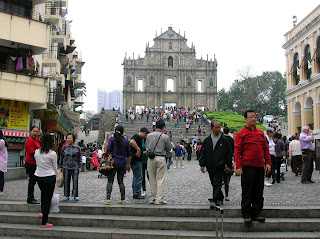After visiting St.
Anthony’s Cathedral, we walked about a block or two along a
cobblestone street (see first pic below) to go to arguably Macau’s
most famous and top tourist attraction: the Ruins of St. Paul’s.
The Ruins of St. Paul’s
refer to the facade of what were originally the Church of Mater Dei
built in 1602-1640, destroyed by fire in 1835, and the ruins of St.
Paul’s College, which stood adjacent to the Church. As a whole,
the old Church of Mater Dei, St. Paul’s College, and Mount Fortress
were all Jesuit constructions and formed what can be perceived as the
‘Acropolis’ of Macau and the cathedral was one of the largest
Catholic churches in Asia at the time. Close by, the archaeological
remains of the old College of St. Paul stand witness to what was the
first western-style university in the Far East, with an elaborate
academic program. In the fire caused by a typhoon, the college and
church burned – ravaging almost all of the complex, leaving only
the facade, most of the foundations, and the front steps. The facade
displays a special mix of eastern and western styles and nowadays,
the facade of the Ruins of St. Paul’s functions symbolically as an
altar to the city. From 1990-1995, work was carried out to restore
the precinct where the church stood in former years, turning it into
a museum.
The facade is like an
altar piece reached by going up the imposing flight of steps and
invites the faithful to pray. It is divided into four horizontal
sections, topped with a pediment and nine vertical divisions which
contains various symbols that tell a story. Basically, the facade
can be divided into two major sections: a rectangle corresponding to
the two lower rows and a triangle.
Right next to the facade
ruins, on a hilltop, stands Mount Fortress. Built in conjunction
with the Jesuits from 1617 to 1626, this was the city’s principal
military defense structure and network. The fortress was equipped
with cannons, military barracks, wells, and an arsenal that held
sufficient ammunition and supplies to endure a siege lasting up to
two years. The fortress covers an area of 10,000 square meters, in
the shape of a trapezoid. The four corners of the fortress protrude
to form bulwarks. Originally, the the mount was used for over 300
years as an altar, but was converted into a fortress by the
Portuguese. The fortress later became the official residence of the
Governor of Macau, and then army barracks, a prison, and an
observatory. It's a great place to come for panoramic views of the
Ruins of St. Paul's and the whole of Macau and there is a tree
covered park at the top.
Walking to the Ruins from St. Anthony's Church...
Pics of the Ruins...
The next pic is a shot taken when I climbed the platform behind the facade...
Now, a pic overlooking Jesus Square. The buildings surrounding the square were constructed between 1920-1930 apart from two that are 19th century neo-classical.
The next few pics are of Mount Fortress...
And some panoramic shots atop the hilltop...
Walking to the Ruins from St. Anthony's Church...
Pics of the Ruins...
The next pic is a shot taken when I climbed the platform behind the facade...
Now, a pic overlooking Jesus Square. The buildings surrounding the square were constructed between 1920-1930 apart from two that are 19th century neo-classical.
The next few pics are of Mount Fortress...
And some panoramic shots atop the hilltop...

















love the header. unusual alley way type of place and of course....love the red lanterns.
ReplyDeletenow isn't this really something. that last pic is really something. so sad but still happy that the facade is still standing. see the statues on the front.i count 7 including the bird. the mystical no. in Christendom. The cannons and the museum. The staircase and the view --o wow!!!! Amazing power of a typhoon and its destruction. I must applaud these priests in history for their hard work and preserverance to keep our religion. Great post. Great pics.Sorry the computer probs but glad we got to see this.
ReplyDeleteThat facade is so awesome...amazing it was left like that after the typhoon and fire. Very cool.
ReplyDelete